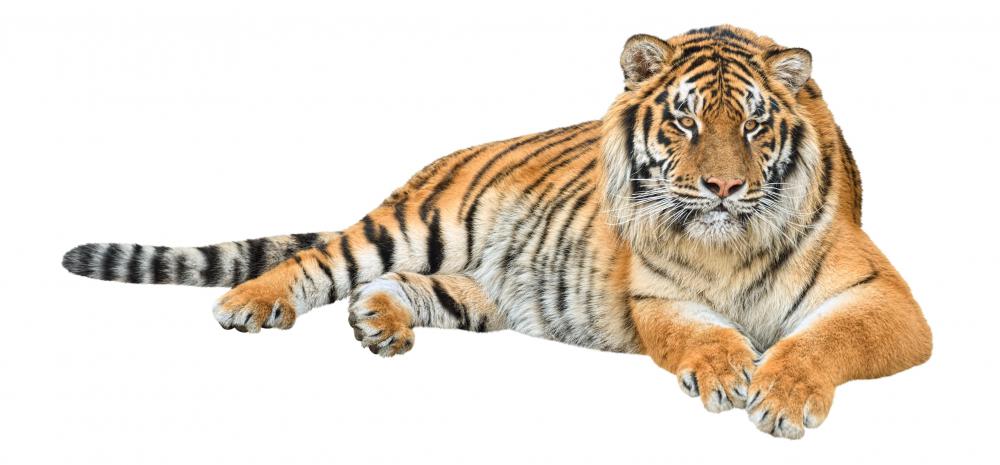At AllThingsNature, we're committed to delivering accurate, trustworthy information. Our expert-authored content is rigorously fact-checked and sourced from credible authorities. Discover how we uphold the highest standards in providing you with reliable knowledge.
What are the Different Types of Rainforest Species?
A rainforest is a dense four layer jungle with a humid and hot climate that experiences a great amount of rainfall annually. Tropical rainforest covers only 6 percent of the world but it is estimated that nearly half of the planet’s plant and animal species live in the rainforests of Central America, Africa, Southern Asia and Australia. Mammals, reptiles, amphibians, arthropods, plants and birds are all common types of rainforest species. In addition to animal and plant biodiversity, many products like chocolate, sugar, cinnamon and pineapple are grown in rainforests.
Rainforests have dense canopy layers that prevent much light from reaching the forest floor. As a result, many plant rainforest species such as the epiphytes or air plants that live on the branches and trunks of trees have evolved including several tropical orchid species. Some fig plants will slowly strangle a host tree as it grows up toward the sun. Other plants such as the venus flytrap are carnivorous and will consume insects. Nepenthes rafflesiana, a pitcher plant common in Southeast Asia, can grow to more than 30 feet (9 meters) and produces 12-inch (30-centimeter) long pitchers that trap not only insects but small reptiles and mammals as well.

There are many large mammalian rainforest species. The gorilla inhabits Central Africa, eats fruit and bark and can weigh up to 400 pounds (181 kg) and stand 6 feet tall (1.8 m). Orangutans live in Indonesia, have a diet similar to that of the gorilla but are smaller, weighing up to 250 pounds (113 kg). In Southeast Asia, India and China roam bengal tigers that eat antelopes, monkeys, pigs and even elephants while the jaguar of Central America prefers turtles and deer. Capybaras can weigh up to 100 pounds (45 kg), are found in South America and are skilled swimmers that eat water plants and fruit.

Rainforest species also include amphibians and reptiles. The colorful poison dart and red-eyed tree frogs inhabit the regions of Central and South America and consume insects such as crickets and flies. Rainforest reptiles can be large, such as the anaconda of the Amazon River Basin that can be more than 37 feet long (11 meters). Anacondas will eat primarily rodents, birds, fish and turtles. Other common reptiles include the black caiman, boa constrictor, gaboon viper and reticulated python.

Many common rainforest species are birds or arthropods. The resplendent quetzal of Central America boasts a tail of red and blue feathers that is nearly 25 inches long (63.5 cm). Another brilliantly colored bird is the toucan that lives in hollow trees and eats fruit. The leafcutter ant has strong jaws for cutting leaves and grass used to grow the fungi it eats. While the leafcutter inhabits the forest floor, high in the canopy lives the brown winged blue morpho butterfly where it consumes rotten fruit. Additional rainforest arthropods are the praying mantis, giant water spider and paper wasp.
Frequently Asked Questions
What are the main types of species found in rainforests?

Rainforests are biodiversity hotspots, home to a vast array of species including insects, amphibians, birds, mammals, and reptiles. Notably, over 50% of the world's plant and animal species reside in these lush ecosystems. Among the most iconic are jaguars, sloths, toucans, orangutans, and countless insect species, each playing a crucial role in the rainforest's complex ecological web.
How many species are discovered in rainforests annually?

According to the World Wildlife Fund, scientists estimate that thousands of new species are discovered in rainforests each year. This highlights the rainforests' immense, yet still largely unexplored, biodiversity. These discoveries range from new insect species to previously unknown mammals, plants, and microorganisms, all contributing to our understanding of these rich ecosystems.
Are there unique plant species in rainforests?

Rainforests are teeming with unique plant species, including towering hardwood trees, exotic orchids, and carnivorous plants like the Venus flytrap. These forests are home to over 2,500 species of vines alone and provide more than 70% of the anti-cancer plants identified to date, underscoring their medicinal importance to humanity.
What adaptations do rainforest species have?

Rainforest species exhibit remarkable adaptations to thrive in dense, humid environments. For instance, many trees have buttress roots for stability and nutrient absorption, while animals like the red-eyed tree frog have developed suction-cup-like toes for climbing. Camouflage and mimicry are also widespread, allowing creatures like the leaf-tailed gecko to evade predators.
How do rainforest species contribute to the ecosystem's health?

Rainforest species contribute to ecosystem health through pollination, seed dispersal, and maintaining food chains. For example, fruit-eating animals like toucans play a vital role in seed dispersal, while decomposers like termites recycle nutrients. Predators, such as jaguars, keep herbivore populations in check, preventing overgrazing and ensuring diverse plant growth.
What is the impact of deforestation on rainforest species?

Deforestation has a devastating impact on rainforest species, leading to habitat loss and fragmentation. This not only reduces biodiversity but also threatens the survival of species, many of which are endemic and cannot be found elsewhere. The International Union for Conservation of Nature (IUCN) has listed numerous rainforest species as endangered or critically endangered due to deforestation.
AS FEATURED ON:
AS FEATURED ON:



















Discuss this Article
Post your comments